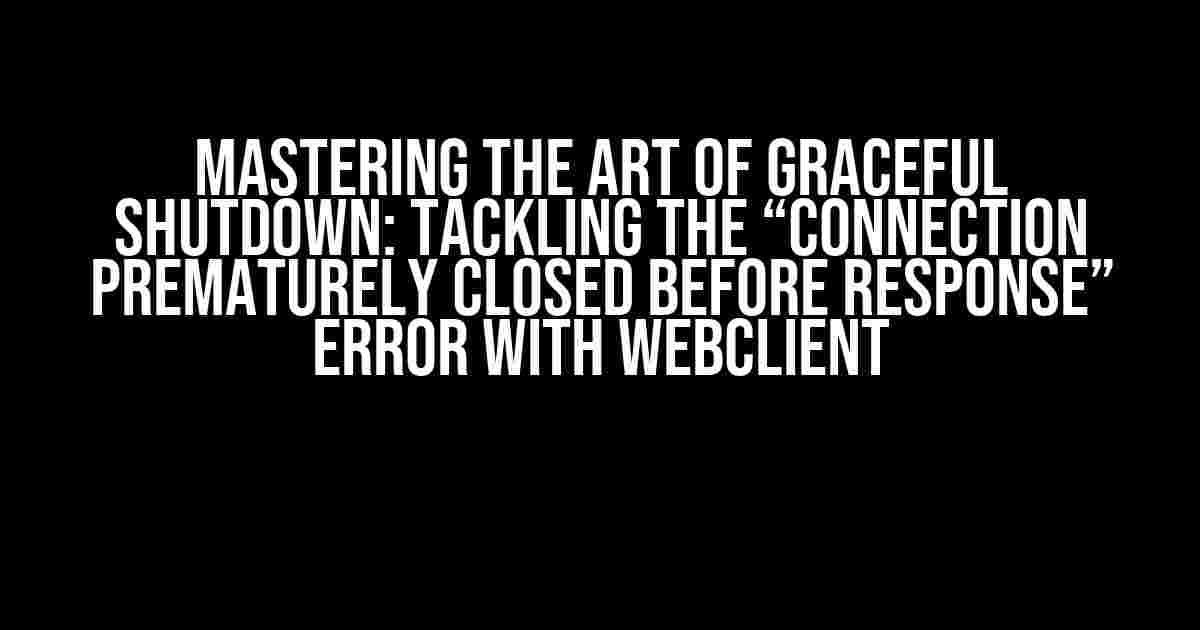As a developer, you’ve probably encountered the frustrating “Connection Prematurely Closed BEFORE Response” error when working with WebClient. This error can be particularly vexing, especially when you’re trying to implement a graceful shutdown. Fear not, dear reader, for we’re about to dive into the world of WebClient and explore the secrets of a seamless shutdown.
What is a Graceful Shutdown, Anyway?
A graceful shutdown is a process that allows your application to shut down smoothly, without interrupting ongoing operations or leaving resources in an unstable state. In the context of WebClient, a graceful shutdown is crucial when dealing with network requests, as it ensures that active connections are closed properly, and any pending responses are handled correctly.
The “Connection Prematurely Closed BEFORE Response” Error: What’s Going On?
This error typically occurs when WebClient is forced to shut down before receiving a response from the server. This can happen due to various reasons, such as:
- The server takes too long to respond, and the WebClient times out.
- The network connection is lost or interrupted.
- The WebClient is forcefully shut down or disposed of.
In any of these scenarios, the “Connection Prematurely Closed BEFORE Response” error is raised, indicating that the connection was terminated before the response was received.
Implementing a Graceful Shutdown with WebClient
To avoid the “Connection Prematurely Closed BEFORE Response” error and ensure a smooth shutdown, follow these step-by-step instructions:
-
Use the
usingStatementWrap your WebClient instances in a
usingstatement to ensure that resources are released properly:<code> using (var client = new WebClient()) { // Your code here } </code> -
Handle Async Operations Correctly
When working with async operations, make sure to await the completion of the task before shutting down:
<code> var task = client.DownloadStringAsync("https://example.com"); task.Wait(); </code> -
Cancel Pending Operations
If you need to cancel pending operations, use the
CancellationTokenclass:<code> var cts = new CancellationTokenSource(); var task = client.DownloadStringAsync("https://example.com", cts.Token); // Cancel the operation cts.Cancel(); </code> -
Dispose of WebClient Instances
Manually dispose of WebClient instances to release system resources:
<code> client.Dispose(); </code>
| Best Practice | Description |
|---|---|
| Use a single WebClient instance | Reusing a single WebClient instance can help reduce the risk of connection errors. |
| Implement timeout handling | Set timeouts for WebClient operations to prevent long-running requests from blocking the shutdown process. |
| Monitor WebClient status | Keep track of WebClient status to detect and handle connection errors promptly. |
Real-World Scenario: Implementing a Graceful Shutdown in a Console Application
Let’s create a simple console application that demonstrates a graceful shutdown using WebClient:
<code>
using System;
using System.Net;
using System.Threading;
using System.Threading.Tasks;
class Program
{
static async Task Main(string[] args)
{
using (var client = new WebClient())
{
try
{
Console.WriteLine("Starting download...");
var task = client.DownloadStringTaskAsync("https://example.com");
await task;
Console.WriteLine("Download completed.");
}
catch (WebException ex)
{
Console.WriteLine("Error: " + ex.Message);
}
finally
{
Console.WriteLine("Shutting down...");
client.Dispose();
Console.WriteLine("Shutdown complete.");
}
}
}
}
</code>
In this example, we:
- Wrap the WebClient instance in a
usingstatement. - Use the
DownloadStringTaskAsyncmethod to download the data. - Catch any exceptions that occur during the download process.
- Dispose of the WebClient instance in the
finallyblock to ensure resources are released.
Conclusion
In this article, we’ve explored the importance of implementing a graceful shutdown when working with WebClient, and how to avoid the “Connection Prematurely Closed BEFORE Response” error. By following the best practices outlined above, you’ll be well on your way to creating robust and reliable applications that handle shutdowns with ease.
Remember, a graceful shutdown is not just about avoiding errors; it’s about providing a seamless user experience, even in the face of unexpected events. By mastering the art of shutdown, you’ll be able to create applications that are not only reliable but also respectful of system resources.
Happy coding!
Here are 5 FAQs about “Graceful shutdown about Webclient with ‘Connection prematurely closed BEFORE response'”:
Frequently Asked Question
When working with WebClient, have you ever encountered the frustrating error “Connection prematurely closed BEFORE response”? Worry no more! Our FAQs have got you covered.
What causes the “Connection prematurely closed BEFORE response” error in WebClient?
This error usually occurs when the WebClient is closed or disposed of before the response is fully received. This can happen when you’re trying to download a large file or the server takes a long time to respond.
How can I avoid this error when using WebClient?
To avoid this error, make sure to keep the WebClient open until the response is fully received. You can use the `DownloadFileAsync` method instead of `DownloadFile` to allow the WebClient to complete the download before closing.
What’s the difference between `DownloadFile` and `DownloadFileAsync` in WebClient?
The main difference is that `DownloadFile` is a synchronous method that blocks the calling thread until the download is complete, while `DownloadFileAsync` is an asynchronous method that allows the calling thread to continue executing while the download is in progress.
How can I handle timeouts when using WebClient to avoid the “Connection prematurely closed BEFORE response” error?
You can set the `Timeout` property of the WebClient to a higher value to give the server more time to respond. You can also use the `AsyncWaitHandle` property to wait for the asynchronous operation to complete within a specified timeout period.
What’s the best way to implement a graceful shutdown when using WebClient?
To implement a graceful shutdown, you can use a combination of `CancelAsync` method and `Timeout` property. Set the `Timeout` to a reasonable value, and then call `CancelAsync` to cancel the download when the timeout expires. This ensures that the WebClient is closed cleanly and avoids the “Connection prematurely closed BEFORE response” error.
